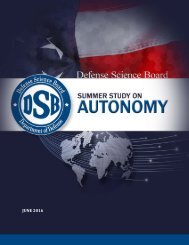Machine learning
machine-learning-conference-report
machine-learning-conference-report
Create successful ePaper yourself
Turn your PDF publications into a flip-book with our unique Google optimized e-Paper software.
FIGURE 6<br />
The machine <strong>learning</strong> software gives an accurate prediction to the whole image of a road junction (left), describing it<br />
as “a road side that is naming two roads which is at a cross road”, but is unable to identify a subset of the same image<br />
(right), which it describes as either a “nematode”, “sea snake”, “sand bar” or “hockey puck”.<br />
© BT<br />
In the future, the role of machine <strong>learning</strong> in robotic<br />
vision will be to augment and replace hand-engineered<br />
elements of the system, making it more robust and<br />
accurate overall. Already the data being obtained from<br />
SLAM systems will be able to provide data to train and<br />
develop the next generation of deep <strong>learning</strong> algorithms.<br />
Low power hardware in combination with parallel,<br />
heterogeneous algorithms and neuromorphic processor<br />
networks will eventually lead to mass-market devices.<br />
<strong>Machine</strong> <strong>learning</strong> in telecommunications<br />
It is not only in newer industries, such as online media<br />
providers or mobile phone speech recognition, where<br />
machine <strong>learning</strong> is making headway. Even in a large,<br />
established sector like telecommunications, usage of<br />
machine <strong>learning</strong> is widespread. Dr Simon Thompson,<br />
BT Research, described how his company uses machine<br />
<strong>learning</strong> throughout many parts of its operations,<br />
from content recommendation and fraud detection to<br />
customer relationships and automated route planning for<br />
their field engineers.<br />
However, Thompson described the difficulties of<br />
implementing machine <strong>learning</strong> in older industries<br />
such as telecommunications and banking, where there<br />
is a problem with legacy systems with thousands of<br />
databases connected into a “federated data estate.”<br />
“Getting data out of a legacy system is an expensive job”,<br />
he observed. Even when acquired, there are a myriad<br />
of steps needed to prepare the data before it can be<br />
analysed using machine <strong>learning</strong>, including dealing with<br />
noise, missing values, and orphaned records.<br />
The current limitations in machine <strong>learning</strong> mean we<br />
need to view it currently as a tool used by people to<br />
manage, process, and deploy solutions to problems. For<br />
example, today’s image recognition software are good<br />
at recognising whole images but perform less well when<br />
looking at sub-components of them. This failure is an<br />
artefact of the training regime and objective function of<br />
the deep network used and represents a gap between<br />
the conception of the system and the reality of it as<br />
implemented, i.e. between the idea of what the machine<br />
has ‘learned’ and what it can actually do in practice.<br />
Overcoming this gap is one challenge for turning state<br />
of the art algorithms into systems that deliver real world<br />
business value.<br />
<strong>Machine</strong> <strong>learning</strong> report – Conference report 13




